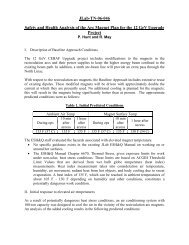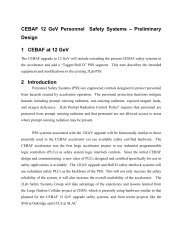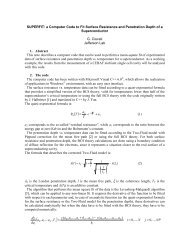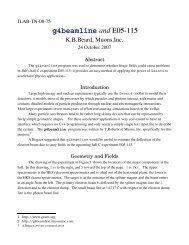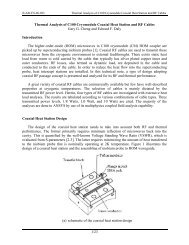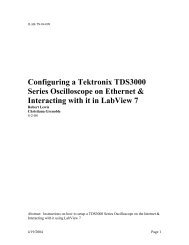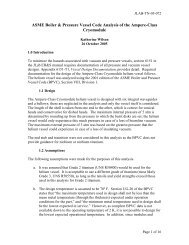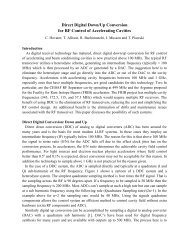Workshop on Polarized Electron Sources and Polarimeters
Workshop on Polarized Electron Sources and Polarimeters
Workshop on Polarized Electron Sources and Polarimeters
Create successful ePaper yourself
Turn your PDF publications into a flip-book with our unique Google optimized e-Paper software.
of surface cleaning for NEA photoemitters. Good results were achieved if a thermal hydrogen<br />
cracker was used, which may be due to the absence of energetic i<strong>on</strong>s <strong>and</strong> neutrals<br />
in the atomic beam of this source.<br />
HYDROGEN CLEANING APPARATUS<br />
We have set up a dedicated apparatus, called HABS - Hydrogen Atomic Beam Source -<br />
which allows for the following operati<strong>on</strong>s<br />
• Hydrogen cleaning by a beam of thermally cracked hydrogen atoms.<br />
• Activati<strong>on</strong> to NEA state <strong>and</strong> q.e. measurement in order to test cleaning effect.<br />
• Transfer of samples under UHV to other apparatuses for further investigati<strong>on</strong>s.<br />
The apparatus c<strong>on</strong>sists of a bakeable all metal UHV system (fig. 1). The hydrogen source<br />
is a commercial <strong>on</strong>e, similar to the design in [4]. It c<strong>on</strong>sists of a heated tungsten capillary<br />
which reaches a temperature of about 2150 C at a heating power of 300 watts. H2 flowing<br />
through the hot capillary is dissociated. A beam of atomic hydrogen then hits the sample<br />
surface which is located at a distance of about 10 cm from the end of the capillary. The<br />
dissociator is enclosed in a water cooled copper shielding which reduces the radiative<br />
heating of the inner surfaces <strong>and</strong> of the sample itself. Clean hydrogen is provided by<br />
using pure H2 gas <strong>and</strong> further purificati<strong>on</strong> is achieved by letting it stream through<br />
a getter. H2 is then stored in an all metal enclosure <strong>and</strong> introduced by a leak valve.<br />
Hydrogen pressure during treatment was 2 · 10 −6 mbar stabilized by a turbo pump (fig.<br />
1). Typical exposure times were about 5 minutes during which the samples are heated<br />
to 550 ◦ C. Then, the activati<strong>on</strong> procedure is started, c<strong>on</strong>sisting of a 30 minute l<strong>on</strong>g heat<br />
treatment at 550 ◦ C <strong>and</strong> co-depositi<strong>on</strong> of cesium <strong>and</strong> oxygen after cooling down the<br />
sample. The q.e. achieved may be compared with the <strong>on</strong>e from untreated samples (fig. 3).<br />
Once a promising result is achieved, the samples are cleaned again without subsequent<br />
activati<strong>on</strong>. Afterwards they are transported to <strong>on</strong>e of the 100 keV sources in our labs<br />
for further investigati<strong>on</strong>s which are not possible within HABS (e.g. polarimetry). For<br />
this purpose the samples are transferred into the transport vessel by a manipulator. The<br />
vessel is equipped with an i<strong>on</strong> pump. An intermediate loading chamber is pumped by<br />
the turbo already menti<strong>on</strong>ed above. After shutting off the transfer vessel by a valve the<br />
loading chamber is vented <strong>and</strong> the vessel may be removed. Meanwhile, another (closed)<br />
valve allows to keep the vacuum in the HABS chamber. The vessel is then transported<br />
to <strong>on</strong>e of the electr<strong>on</strong> sources where similar loading chambers exist. All stages of the<br />
transport are performed under UHV.<br />
HABS RESULTS<br />
Photocathodes: The structure of the superlattice (SL-)cathodes labelled 7-395 <strong>and</strong> 7-<br />
396 is presented in fig. 2. In both cases the working layer c<strong>on</strong>sists of 12 periods of double<br />
layers with a compositi<strong>on</strong> In.2Al.19Ga.61As/Al.4Ga.6As, yielding a total thickness of<br />
91 nm for the working layer of the cathode. Due to the fact that all layers c<strong>on</strong>tain Al it is<br />
necessary to inhibit interacti<strong>on</strong> with oxygen by placing a very thin layer of GaAs <strong>on</strong> top



